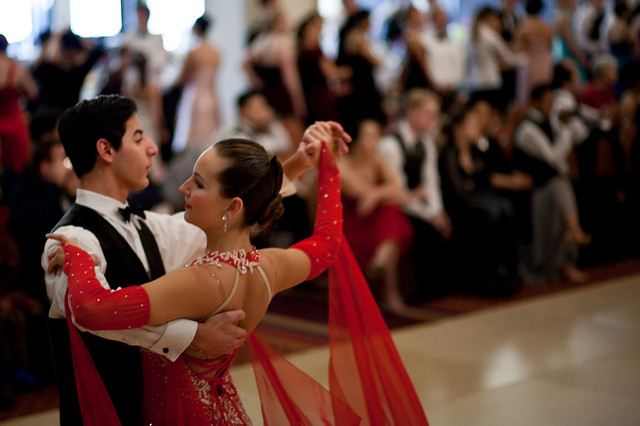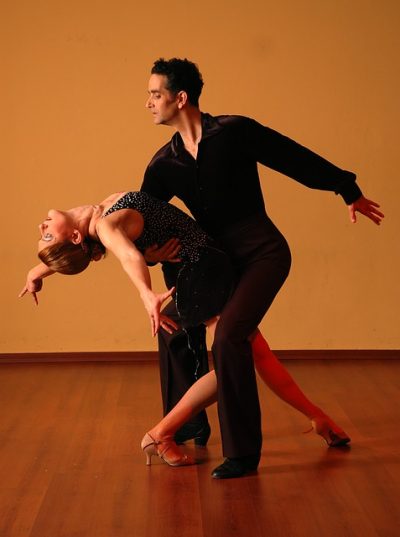Thanks to shows like “Dancing With the Stars” and “So You Think You Can Dance,” ballroom and latin dances are being pulled out of Jane Austen novels and brought to this millenia. The world of technical, competitive ballroom has been evolving and thriving since the 1950s, but somewhere along the way it got a reputation for being boring and stuffy.
The reality couldn’t be farther from the truth. Dancesport competitions are loud affairs full of colorful costumes, outrageously sculpted hair, and more rhinestones than you can count. The dancing ranges from the sassy, sultry foxtrot to the flirty, rhythmic samba and back to the elegance of waltz. Dance categories are divided into American Smooth, American Rhythm, International Standard, and International Latin — and there’s something for everyone.
If you’re considering taking a technical ballroom class or have already signed up for one, you may have a few questions. This article will address the main concerns dancers have before their first international standard class, as well as a few tips and tricks for success. One point to keep in mind as you’re reading: depending on whether you’re taking the class for fun or with the intent compete or perform will impact the type of class you’re in, the intensity of training, and how much each section applies to you.

Characteristics of the Dances
International standard is made up of five dances: waltz, tango, viennese waltz, foxtrot, and quickstep. Each dance carries a unique style that defines it, but in all standard dances, partners must maintain dance frame for the duration. While music dictates what dance is done, the movements should be unique enough that an observer could identify the dance without hearing the music.
- Waltz is danced on a three count with the partners rising on the two and lowering on the three. Movement is smooth and elegant, and many of the dance figures are turning.
- Tango is the “odd one out” in standard dance. Rather than being fluid, the partnership moves very aggressively and deliberately through syncopated figures, with stops and sharp head turns punctuating the movement.
- Viennese waltz is similar to “slow” waltz in that it’s the same three count, just sped up. The patterns in Viennese waltz are much simpler as the timing doesn’t allow for fanciful steps.
- Foxtrot is a smooth, jazzy dance characterized by changes in timing and long, stretched-out steps with a rise and fall that’s more gradual than waltz.
- Quickstep is exactly what it sounds like — it’s fast. Couples often look more like they’re skipping across the floor than dancing figures. Traditionally the last dance in a competition round, quickstep is a test of stamina and performance.
When you take a standard class, the dances covered may vary depending on the purpose of the class. If you’re in a beginner’s competition class, you’ll likely cover waltz and quickstep, as these are the entry level competition dances. If you’re in a general technique class, it’s more likely that you’ll cover waltz and tango to expose you to the most different aspects of standard. If there are specific dances you’re interested in, you can always reach out to the instructor for the syllabus before class begins, or consider taking private lessons with a partner.
Ballroom Vocabulary
Most classes will do a good job of explaining terminology as you go, but if you’re anything like me and insist on being over-prepared, here’s the very basic lingo you might want to know:
- Lead: the partner responsible for “directing” the dance and giving cues (conventionally the male partner).
- Follow: the partner executing on and maintaining the movement initiated by the lead (conventionally the female partner).
- Figure: a standardized series of steps that create a recognized pattern or movement (for example, an outside turn or a box step).
- Syllabus: the list of recognized figures for each dance, divided by level and difficulty.
- Frame: the upper body position of a partnership, encompassing the arm, shoulder, and neck line.
- Line of dance: a path traveling around the perimeter of the dance floor in a counterclockwise direction.
From there, each teacher, studio, and region will have their own “dialect” of words and phrases used to articulate different parts of the dance.
What to Wear
As with any dance class, what you wear is important. Some classes may have more formal dress codes, so it’s always wise to check with the studio when you enroll. Otherwise, general attire needs to be athletic wear that does not inhibit range of motion. Fitted shirts are often beneficial as nothing will get in the way of your frame and your teacher will be able to make sure you’re not arching or straining your back.
Since you’ll be in contact with your partner consistently, you’ll want to avoid pants with buttons, belts, or thick waistbands. You’ll want to make sure pockets are empty as well. Some ladies will opt to wear a long, ankle-length skirt when following. While this is allowed, it is not required (by most classes) and may actually inhibit a teacher’s ability to correct the movement in your legs.
Shoes should be suede bottomed to allow feet to glide along the floor while maintaining some traction. A classic women’s standard shoe is designed like a pump and has very little flexibility in the sole compared to most dance shoes (you can’t point your toes in a standard heel). Men’s standard shoes look like traditional patent or leather dress shoes with minimal embellishment. While ladies’ shoes come in a variety of colors, men’s are traditionally black.
For practice or beginner’s classes, practice shoes are often allowed as they place less stress on a the feet, especially for women. Practice shoes have a slightly lower heel, and for women, the heel block is much wider, adding stability and support. It’s worth noting, though, that even practice shoes can run up a bill quite quickly. They’re also difficult to find in a brick-and-mortar shop outside of large metropolitan areas. If you do end up ordering online, try to find a brand you know works for your feet and use a trusted vendor with a good return policy in case the shoe doesn’t fit well. Bloch and Capezio make decent ballroom shoes, and if you’re looking to go top of the line, you’ll be looking for Aida, Supadance, Ray Rose, or International.
If you can’t get your hands on ballroom shoes or don’t have the money to spare, character shoes can be a passable introductory pair, though you’ll definitely want to upgrade if you plan on practicing ballroom long term. In an absolute pinch, a jazz soft shoe with a solid heel may be appropriate, though this will offer your toes less protection in the event of a misstep.
 Training Tips
Training Tips
Every style of dance comes with its own movements to learn, its own drills and fundamentals, and its own mental challenges. For individuals who have previous dance experience, transitioning into the world of ballroom can be challenging — especially with standard. Here are some important things to keep in mind while setting out on your journey:
- Be patient. You’re no longer solely responsible for your movement. You are stuck to another person and you have to rely on them for energy, power, and execution — if one of you is off your balance, the whole progression can be thrown off.
- Communicate. Because you are reliant on your partner, it’s incredibly important that you develop positive communication practices. It’s all too easy to blame your partner, so when something goes wrong, focus on solving the problem and elevating the partnership rather than assigning blame. The skills you develop will help you personally and professionally, and could even give you an experience boost in the hunt for your first job.
- Practice on your own. Even though standard is fundamentally partnered, your coach or teacher will likely give you drills that can be practiced on your own. For instance, a basic walking drill in waltz will integrate rolling through your feet and help keep your feet in parallel (that’s right — there’s no turnout in standard!).
- Cross train. Every dance style benefits from cross training, but in standard, and especially for follows, you’ll actually become lopsided if you don’t. Because you’re holding an offset position for almost the entirety of the dance, you engage one side of your back and core more than the other and utilize your legs differently, which can impact your practice in other styles. Weight training and plyometrics, as well as flexibility training, can help to balance you out.
- Stay hygienically aware. As much as I wish it didn’t need to be said, it does. Since you’re dancing in such close proximity to your partner, make sure to wear deoderant, bring a clean shirt if you’re coming straight from another class, and avoid the onions in your lunch. It only takes one bad partner to ruin a class.
- Have fun. Above all else, enjoy the journey. If you’re learning just to learn, appreciate the nuances that make standard unique. If you’re prepping for a performance, find the aspect of each dance that lets your personality shine. If you’re getting ready to compete, work hard, and then let loose. There’s nothing quite like getting dolled up for a ballroom competition!
 Alyssa Robinson is a lover of words and movement who happily resides in the Pacific Northwest. She started dancing at 19 when the ballroom (and latin) bug bit her, and she hasn’t stopped since. If she’s not writing about food, fitness, and dance, she’s in the studio training for her next ballroom competition.
Alyssa Robinson is a lover of words and movement who happily resides in the Pacific Northwest. She started dancing at 19 when the ballroom (and latin) bug bit her, and she hasn’t stopped since. If she’s not writing about food, fitness, and dance, she’s in the studio training for her next ballroom competition.

Dance Advantage welcomes guest posts from other dance teachers, students, parents, professionals, or those knowledgeable in related fields. If you are interested in having your article published at Dance Advantage, please see the following info on submitting a guest post. Read posts from guest contributors.

